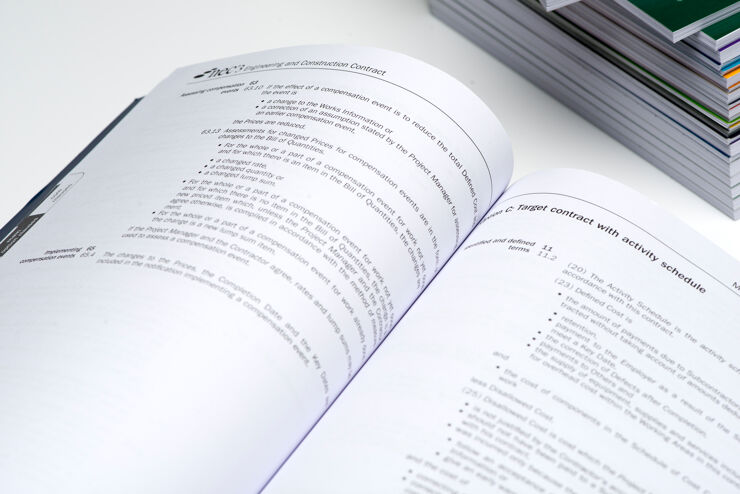
Key Points
- In NEC4 ECC, contract data part one is completed by the client and contract data part two says it should be completed by the contractor.
- However, parts of contract data part two, such as key people and equipment, could be filled in by a client before issuing tenders to help ensure a level playing field in assessing bids.
- Bidders may still be invited to add to the lists of key people and equipment which a client has stated.
Most NEC contracts have contract data part one, data provided by the client, and contract data part two, data provided by the contractor. This article is based on the NEC4 Engineering and Construction Contract (ECC), but the principles are similar for most other NEC4 contracts.
It is often overlooked that when a contractor completes contract data part two, it is as a bidder and not yet the ‘Contractor’. Clients should consider completing certain items in part two before tender documents are issued to help ensure a level playing field when assessing bids. These items are discussed in this article in the order in which they appear in part two.
All items in the contract data are pointed to by either the contract or the schedules of cost components, as noted below.
General: key persons
The key people named in contract part two are required by clause 24.1 to be used by the contractor unless they get a replacement accepted by the project manager. For each key person, part two requires their name, job, responsibilities, qualifications and experience. Key people are often part of tender quality assessments, so clients should have a consistent set of roles to compare.
ECC does not have a named contractor’s representative, so clients should ensure this is first job in the list to clarify who makes decisions on behalf of the contractor. If the contract involves significant design, another job should be the design manager. The client may also want to see a health and safety manager, environmental manager, planner and quality manager. The client could also start the list of responsibilities of these jobs and include minimum qualifications and experience.
Sometimes clients choose to put some of the above information in the scope, but it is neater to keep it all in contract data part two, which also means the project manager cannot subsequently change it.
Payment: Options A and C activity schedule
Although the activity schedule for NEC4 ECC Option A (priced contract with activity schedule) and Option C (target contract with activity schedule) is normally put together by the contractor to match its programme, the client may benefit from providing a skeleton structure as a starting point in contract data part two. At tender stage this can help the client to understand how each contractor has priced the work.
X22 early contractor involvement
The above section on key persons will also apply to the stage one key persons required to be listed in contract data part two if option X22 on early contractor involvement is selected. Contract clause X22.4 points to these key people. Given that projects using X22 are not tendered with the price of the construction stage (establishing this price is a key activity of stage one), bids are largely evaluated on the strength of the contractor’s team. Identifying the key jobs in this team is a logical step for the client.
Data for the schedule of cost components
The first table in contract data part two for the schedule of cost components (SCC) in Options C, D (target contract with bill of quantities) and E (cost reimbursable contract) relates to the third bullet in SCC 1, which is categories of people not in the working areas but for who the contractor is paid their real cost within defined cost. This was developed in the NEC4 January 2023 amendments, primarily to cover people working from home.
Anyone not included here and not working in the working areas will have to be included in the bidder’s fee percentage. It makes sense for this table to be completed by the client so all bidders are bidding on the same basis. It also allows the client to state, for example, that quantity surveyors working on the contract can be paid whether or not they are in the working areas.
The next table relates to the equipment purchased for work on the contract with an on-cost charge (SCC 23). If this is likely to be a significant cost, such as a tunnel boring machine, a client can define the type of equipment it wishes the bidder to price. The special equipment table (SCC 24) is also appropriate for the client to include equipment it knows will be required and for which it will be difficult to agree an ‘open market or competitively tendered price’ (clause 52.1), such as a dredging barge.
The table for rates for defined cost of design outside the working areas (SCC 71) also requires rates for categories of person, but this only applies only to the contractor’s in-house designers. The client should know the types and grades of designer for which it wants a rate so should pre-enter the categories of person. Any descriptions of experience (if needed) should be included as an appendix to the contract data part two and pointed to from the contract data.
Finally, in the table for categories of design people whose travelling expenses to and from the working areas are included as a cost of design of the works and equipment done outside the working areas (SCC 72), the client should for simplicity enter either ‘none’ or ‘all’. If none, the bidder will have to include for such travelling expenses in its tendered rates for people, if all, the client may have to pay the international air fares of visiting designers.
Data for the short schedule of cost components
The first table in contract data part two for the shorter schedule of cost components (SCC) in Options A and B (priced contract with bill of quantities) is for people rates (SSCC 11), which requires the rates for categories of person. The client should know the types of people for which it wants a rate and so should pre-enter the categories of person so these can be competitively tendered and form part of the bid evaluation. Again, descriptions of minimum experience required should be included. It may also be appropriate to invite rates for other categories specified by the bidder.
The published list of equipment (SSCC 21) in contract data part two is what most of the defined cost of equipment in Options A and B will be assessed on. Bidders are also required to state a percentage for adjustment for equipment in the published list. It is essential for the client to state the published list of equipment so the percentages for adjustment are competitively tendered. In the UK, most clients enter the Civil Engineering Contractors Association’s Schedules of Contractor Equipment Rates for Use on Construction Contracts Including Rail Equipment Items, 2nd Edition, April 2022, Volumes 1 and 2.
The table for rates for other equipment (SSCC 22) is equipment not included in the published list of equipment. The client may be aware of other items of equipment for which it wants a rate and state them here. For the remaining tables on rates for manufacture (SSCC 61) and design (SSCC 71) outside the working areas and travelling design people (SSCC 72), see the comments above for similar tables in the SCC.
While the client is not required to complete the above sections in contract data part two, there is clear benefit in doing so for both tender evaluation and ongoing contract administration reasons.




